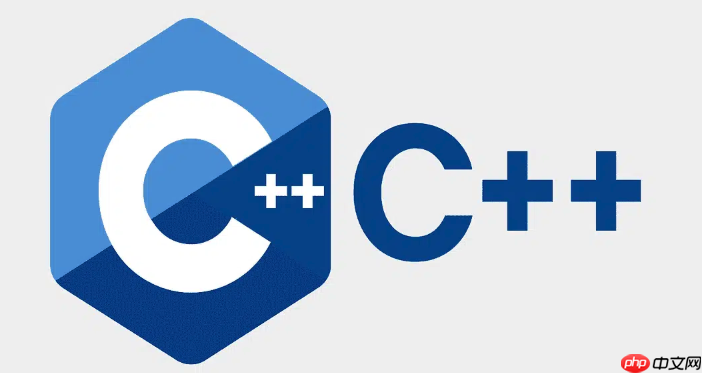并发队列在c++++中处理的核心在于使用原子操作和内存屏障实现线程安全,1. 通过环形缓冲区与std::atomic实现单生产者/单消费者模型;2. 多生产者/多消费者场景需使用cas操作解决竞争条件;3. aba问题可通过版本号或hazard pointer解决;4. 内存顺序选择需权衡性能与正确性,如acquire/release用于同步;5. 其他无锁结构包括hazard pointer、rcu及无锁哈希表;6. 性能测试应涵盖吞吐量、延迟及可扩展性;7. 实际应用适用于高并发服务器、实时系统及操作系统内核。

并发队列在C++中处理的核心在于如何在多线程环境下安全地进行入队和出队操作,同时尽量减少锁的使用,以提高性能。无锁数据结构提供了一种避免锁竞争的方案,但实现起来也更复杂。

解决方案

在C++中,可以使用原子操作和内存屏障来实现无锁并发队列。以下是一个基于单生产者/单消费者模型的简单示例,并随后讨论更通用的情况。
立即学习“C++免费学习笔记(深入)”;
#include <iostream>
#include <thread>
#include <atomic>
template <typename T>
class LockFreeQueue {
private:
T* buffer;
int capacity;
std::atomic<int> head; // 生产者写入位置
std::atomic<int> tail; // 消费者读取位置
public:
LockFreeQueue(int capacity) : capacity(capacity), head(0), tail(0) {
buffer = new T[capacity];
}
~LockFreeQueue() {
delete[] buffer;
}
bool enqueue(const T& item) {
int current_head = head.load(std::memory_order_relaxed);
int next_head = (current_head + 1) % capacity;
if (next_head == tail.load(std::memory_order_acquire)) { // 队列满
return false;
}
buffer[current_head] = item;
head.store(next_head, std::memory_order_release);
return true;
}
bool dequeue(T& item) {
int current_tail = tail.load(std::memory_order_relaxed);
if (current_tail == head.load(std::memory_order_acquire)) { // 队列空
return false;
}
item = buffer[current_tail];
int next_tail = (current_tail + 1) % capacity;
tail.store(next_tail, std::memory_order_release);
return true;
}
};
int main() {
LockFreeQueue<int> queue(10);
std::thread producer([&]() {
for (int i = 0; i < 20; ++i) {
while (!queue.enqueue(i));
std::cout << "Enqueued: " << i << std::endl;
std::this_thread::sleep_for(std::chrono::milliseconds(10));
}
});
std::thread consumer([&]() {
for (int i = 0; i < 20; ++i) {
int item;
while (!queue.dequeue(item));
std::cout << "Dequeued: " << item << std::endl;
std::this_thread::sleep_for(std::chrono::milliseconds(20));
}
});
producer.join();
consumer.join();
return 0;
}这个例子使用了一个环形缓冲区,head 指向下一个可写入的位置,tail 指向下一个可读取的位置。std::atomic 用于保证 head 和 tail 的原子性操作。std::memory_order_acquire 和 std::memory_order_release 用于确保内存屏障,防止指令重排,保证数据的一致性。

单生产者/单消费者的局限性: 上述代码仅适用于单生产者和单消费者。在多生产者/多消费者场景下,需要更复杂的算法,比如使用CAS(Compare and Swap)操作。
多生产者/多消费者并发队列的核心挑战在于如何避免多个线程同时修改 head 和 tail,以及如何处理竞争条件。使用CAS操作是一种常见的解决方案。CAS操作允许原子地比较一个变量的值和一个期望值,如果相等,则将变量设置为新的值。
以下是一个基于CAS操作的无锁队列的简化版本(需要注意的是,实际应用中需要处理ABA问题,这里为了简化而忽略):
#include <iostream>
#include <thread>
#include <atomic>
template <typename T>
struct Node {
T data;
Node<T>* next;
};
template <typename T>
class LockFreeQueue {
private:
std::atomic<Node<T>*> head;
std::atomic<Node<T>*> tail;
public:
LockFreeQueue() {
Node<T>* dummy = new Node<T>;
head.store(dummy);
tail.store(dummy);
}
~LockFreeQueue() {
Node<T>* current = head.load();
while (current != nullptr) {
Node<T>* next = current->next;
delete current;
current = next;
}
}
void enqueue(const T& value) {
Node<T>* newNode = new Node<T>{value, nullptr};
Node<T>* tailNode;
while (true) {
tailNode = tail.load();
Node<T>* nextNode = tailNode->next;
if (tailNode == tail.load()) { // 检查 tail 是否被其他线程修改
if (nextNode == nullptr) {
if (tailNode->next.compare_exchange_weak(nextNode, newNode)) {
tail.compare_exchange_weak(tailNode, newNode); // 更新 tail,允许失败
return;
}
} else {
tail.compare_exchange_weak(tailNode, nextNode); // 帮助其他线程完成 tail 的更新
}
}
}
}
bool dequeue(T& value) {
Node<T>* headNode;
Node<T>* nextNode;
while (true) {
headNode = head.load();
nextNode = headNode->next;
if (headNode == head.load()) { // 检查 head 是否被其他线程修改
if (nextNode == nullptr) {
return false; // 队列为空
}
if (head.compare_exchange_weak(headNode, nextNode)) {
value = nextNode->data;
delete headNode;
return true;
}
}
}
}
};
int main() {
LockFreeQueue<int> queue;
std::thread producer1([&]() {
for (int i = 0; i < 10; ++i) {
queue.enqueue(i);
std::cout << "Producer 1 Enqueued: " << i << std::endl;
std::this_thread::sleep_for(std::chrono::milliseconds(10));
}
});
std::thread producer2([&]() {
for (int i = 10; i < 20; ++i) {
queue.enqueue(i);
std::cout << "Producer 2 Enqueued: " << i << std::endl;
std::this_thread::sleep_for(std::chrono::milliseconds(10));
}
});
std::thread consumer1([&]() {
for (int i = 0; i < 10; ++i) {
int item;
if(queue.dequeue(item)){
std::cout << "Consumer 1 Dequeued: " << item << std::endl;
}
std::this_thread::sleep_for(std::chrono::milliseconds(20));
}
});
std::thread consumer2([&]() {
for (int i = 0; i < 10; ++i) {
int item;
if(queue.dequeue(item)){
std::cout << "Consumer 2 Dequeued: " << item << std::endl;
}
std::this_thread::sleep_for(std::chrono::milliseconds(20));
}
});
producer1.join();
producer2.join();
consumer1.join();
consumer2.join();
return 0;
}这段代码使用链表结构,head 指向队列的头部,tail 指向队列的尾部。enqueue 操作在尾部添加新节点,dequeue 操作从头部移除节点。CAS操作用于原子地更新 head 和 tail。
ABA问题: ABA问题指的是一个值从A变为B,又变回A,导致CAS操作误判。解决方案包括使用版本号或 Hazard Pointer。
内存顺序(Memory Order)是原子操作中一个非常重要的概念,它决定了原子操作对其他线程的可见性。常见的内存顺序包括:
std::memory_order_relaxed: 最宽松的顺序,仅保证原子性,不保证线程间的同步。std::memory_order_acquire: 当一个线程读取一个原子变量时,所有在该原子变量被写入之前发生的写操作,对该线程可见。std::memory_order_release: 当一个线程写入一个原子变量时,所有在该原子变量被写入之后发生的读操作,对其他线程可见。std::memory_order_acq_rel: 同时具有 acquire 和 release 的语义。std::memory_order_seq_cst: 最强的顺序,保证所有原子操作按照全局顺序执行。选择合适的内存顺序需要权衡性能和正确性。通常,relaxed 顺序性能最高,但需要仔细分析代码,确保不会出现数据竞争。seq_cst 顺序最安全,但性能最低。在并发队列中,acquire 和 release 通常用于保证生产者和消费者之间的同步。
除了基于原子操作的并发队列,还有其他无锁数据结构,例如:
无锁数据结构的性能测试至关重要,因为理论上的无锁并不意味着实际性能一定优于基于锁的实现。性能测试应该包括:
可以使用C++的性能测试框架,例如 Google Benchmark,来进行性能测试。需要注意的是,性能测试应该在真实的硬件环境下进行,并且需要考虑不同的工作负载。
无锁数据结构适用于对性能要求极高,且竞争激烈的场景。常见的应用场景包括:
但是,无锁数据结构的实现复杂,调试困难,因此需要仔细评估是否真的需要使用无锁数据结构。在很多情况下,基于锁的并发数据结构已经足够满足性能需求。
以上就是怎样在C++中处理并发队列_无锁数据结构的详细内容,更多请关注php中文网其它相关文章!

每个人都需要一台速度更快、更稳定的 PC。随着时间的推移,垃圾文件、旧注册表数据和不必要的后台进程会占用资源并降低性能。幸运的是,许多工具可以让 Windows 保持平稳运行。




Copyright 2014-2025 https://www.php.cn/ All Rights Reserved | php.cn | 湘ICP备2023035733号